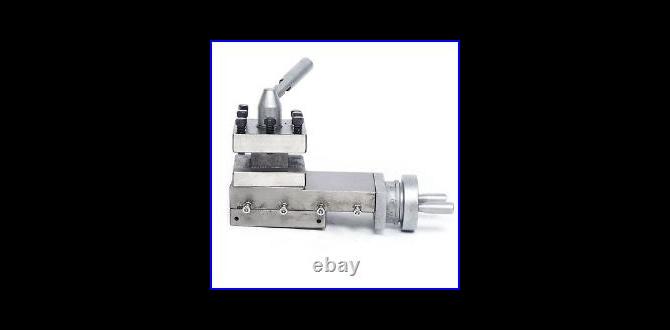Carbide end mills, especially 1/8 inch ones with a 1/2 inch shank and long reach, are essential for achieving precise cuts in fiberglass. They offer superior durability and sharp edges for clean, efficient machining, preventing material damage and ensuring tight tolerances for your projects.
Working with fiberglass can be tricky. It’s a fantastic material for all sorts of creations, from boat parts to custom enclosures, but it also likes to shred and splinter if you’re not careful. Getting clean, accurate cuts, especially when you need super-fine details or need to fit parts together perfectly, can feel like a real challenge. That’s where the magic of a specifically chosen tool comes in. We’re going to dive into why a 1/8-inch carbide end mill, particularly one with a longer shank for that extra reach, is your best friend for achieving that essential precision in fiberglass. This guide will walk you through how to select, use, and maintain this critical tool, making your fiberglass projects smoother and more professional than ever before.
Why a 1/8″ Carbide End Mill is Perfect for Fiberglass
Fiberglass is a composite material made of glass fibers embedded in a resin matrix. This unique composition gives it strength and durability, but it can also be abrasive and prone to chipping or delamination if the wrong cutting tool is used. Carbide is a super-hard material, much harder than high-speed steel (HSS). This means it can cut through tough materials like fiberglass with less wear and a sharper edge, resulting in cleaner cuts and less heat buildup. The 1/8-inch size is ideal for detailed work, while a 1/2-inch shank offers stability and reduces chatter.
When dealing with fiberglass, the goal is to achieve a clean chip without melting or tearing the material. Carbide tools excel at this because they maintain their hardness and sharp cutting edges at higher temperatures than HSS. This is crucial, as the friction generated during cutting can quickly soften or degrade softer materials. For intricate designs or small components, a smaller diameter end mill like a 1/8-inch is indispensable. It allows for tight corners, fine details, and precise paths that larger tools simply can’t manage.
The “long reach” aspect of some 1/8-inch end mills is another significant advantage. Fiberglass fabrication often involves reaching into deeper pockets, across larger surfaces without frequent tool changes, or clearing material from complex geometries. A longer shank provides the necessary clearance, preventing the tool holder or spindle from colliding with the workpiece and allowing for deeper cuts or access to otherwise hard-to-reach areas. This versatility makes it a go-to tool for many fiberglass CNC routing and milling applications.
Key Features to Look For in a 1/8″ Fiberglass End Mill
Not all carbide end mills are created equal, especially when it comes to cutting fiberglass. Here’s what to consider:
Material Composition
For fiberglass, you’ll want a solid carbide end mill. Carbide offers superior hardness and edge retention compared to coated HSS. Look for grades of carbide that are specifically designed for composites or non-ferrous metals. A finer grain carbide will generally provide a sharper edge and better finish on materials like fiberglass.
Number of Flutes
The number of cutting edges (flutes) on an end mill affects chip evacuation and cutting speed. For fiberglass, which can produce fine, powdery chips, a higher flute count is often beneficial:
- 2-Flute End Mills: Excellent for chip clearance, which is vital for preventing overheating and clogging. They generally allow for faster feed rates.
- 4-Flute End Mills: Provide a smoother finish and can handle heavier cuts. However, chip evacuation can be more challenging in soft materials like fiberglass.
For general-purpose fiberglass routing, a 2-flute end mill is often the preferred choice due to its superior chip evacuation capabilities, leading to a cleaner cut and reduced risk of material melting or gumming up the tool. For very fine finishing passes where chip load is minimal, a 4-flute might offer a slightly better surface finish.
Coating
While solid carbide is excellent, specialized coatings can further enhance performance and tool life when cutting fiberglass:
- Uncoated Carbide: A good starting point, especially for hobbyists.
- Zirconium Nitride (ZrN) or Titanium Aluminum Nitride (TiAlN): These coatings add a layer of hardness and thermal resistance, which can significantly improve tool life and cutting performance in abrasive materials like fiberglass.
For those serious about their fiberglass cutting, a coated end mill can offer a noticeable improvement in durability and precision.
Cutting Edge Geometry
The design of the cutting edges is crucial. For fiberglass, look for:
- Sharp Edges: Essential for a clean cut and to minimize splintering.
- Up-Cut vs. Down-Cut vs. Straight Flutes:
- Up-Cut Flutes: Pull chips upwards, away from the workpiece. Good for general milling and can help clear chips from the cut.
- Down-Cut Flutes: Push chips downwards. Excellent for achieving a smooth finish on the top surface, as they hold the material down. They can sometimes lead to chip buildup in the flutes if not managed.
- Straight Flutes: Offer good chip holding and are versatile.
- Specialized Composite End Mills: Some manufacturers offer end mills with unique flute geometries (e.g., “fish-tail” or compression flute designs) specifically for composites, aiming to balance updraft and downdraft cutting actions for a superior finish and clean chip evacuation.
When working with thin fiberglass sheets, a down-cut end mill is often a good choice for the top surface to prevent fuzzing or lifting. For deeper cuts or less critical surface finishes, an up-cut can be more effective at chip removal.
Helix Angle
The helix angle refers to the spiral degree of the flutes. A steeper helix angle (e.g., 45 degrees) generally results in a smoother cut and better chip evacuation but can increase the tendency for the tool to push sideways. A shallower helix angle (e.g., 30 degrees) provides more rigidity and less radial force but may not clear chips as effectively. For fiberglass, a moderate to steep helix angle often works well.
Shank Diameter and Length
As mentioned, a 1/8-inch cutting diameter is ideal for detail. The shank will typically be 1/4-inch or 1/2-inch. A 1/2-inch shank provides more rigidity and reduces vibration compared to a 1/4-inch shank, especially important for longer reach tools. The “long reach” spec will indicate how far the cutting flutes extend from the shank. Ensure this length is sufficient for your intended cuts without the shank bottoming out in your collet or tool holder.
Understanding the CNC Setup for Fiberglass Routing
Using a 1/8-inch carbide end mill on a CNC machine for fiberglass requires careful setup. It’s not just about the tool; it’s about the entire system working in harmony.
Spindle Speed (RPM) and Feed Rate
These two parameters are critically linked. Too slow a feed rate for a given RPM can cause the tool to rub and overheat, melting the resin. Too fast an RPM for the feed rate can lead to inefficient cutting and chatter. For fiberglass, you’re generally looking for moderately high spindle speeds and calculated feed rates to maintain a suitable chip load.
A good starting point might be:
- RPM: 18,000 – 24,000 RPM
- Feed Rate: 30 – 60 inches per minute (IPM)
These are general guidelines. The optimal settings depend heavily on the specific type of fiberglass, the end mill’s geometry, and the rigidity of your CNC machine. It’s always best to consult the end mill manufacturer’s recommendations or run test cuts on scrap material. You can learn more about chip load and feed rate calculations from resources like Machinery Lubricants.
Depth of Cut
For fiberglass, it’s usually best to take shallower depths of cut. This reduces the load on the tool and machine, minimizes the risk of chipping or delamination, and helps with chip evacuation. Instead of one deep pass, plan for multiple shallow passes.
A good starting point for depth of cut might be:
- 0.040″ to 0.125″ (1mm to 3mm)
Again, this is highly dependent on the material thickness and rigidity.
Tool Path Strategy
How you program the tool path can significantly impact the quality of the cut and the life of your end mill.
- Climb Milling vs. Conventional Milling: Climb milling (where the cutter rotates in the same direction as its feed) generally produces a better surface finish and reduces cutting forces. It’s often preferred for materials like fiberglass. Conventional milling can sometimes lead to tool chatter and a rougher finish.
- Tab Management: To prevent small parts from flying off when the cut is complete, leave small tabs connecting them to the main sheet. These tabs can then be manually broken or cut off.
- Pocketing Strategies: For clearing out larger areas, use efficient pocketing tool paths (like adaptive clearing) that maintain a consistent chip load and minimize rapid changes in direction.
Dust Collection and Safety
Working with fiberglass creates fine dust that is not only an irritant but also potentially harmful if inhaled. A robust dust collection system is absolutely essential when routing fiberglass. Ensure your CNC machine is equipped with a good vacuum attachment that can effectively capture dust at the source.
Beyond dust, remember:
- Eye Protection: Always wear safety glasses or a face shield.
- Respiratory Protection: Use a high-quality dust mask or respirator.
- Hearing Protection: CNC machines can be loud.
- Tool Security: Ensure the end mill is securely clamped in the collet and the collet is properly seated in the spindle.
You can find more comprehensive safety guidelines for CNC operations from organizations like the Occupational Safety and Health Administration (OSHA) concerning general machine safety.
Step-by-Step: Using Your 1/8″ Carbide End Mill for Fiberglass
Let’s walk through the process of using your new 1/8-inch carbide end mill for a typical fiberglass project.
Step 1: Design and CAM Programming
Create your design using CAD software. Then, use your CAM software to generate the tool paths. Ensure you select the correct end mill diameter (1/8 inch), tool type (carbide end mill), and choose appropriate machining strategies (e.g., climb milling, depth of cut per pass, feed rate, spindle speed). Set up tabs if needed for part holding.
Step 2: Secure the Material
Properly secure your fiberglass sheet to the CNC machine bed. This is crucial to prevent any movement during cutting, which can lead to inaccurate dimensions or tool breakage. Use clamps, double-sided tape designed for CNC work, or a vacuum table, depending on your machine and material. Ensure there are no gaps under the material where dust can accumulate or the material could shift.
Step 3: Install the End Mill
Install the 1/8-inch carbide end mill into your CNC spindle’s collet. Ensure the collet is clean and the end mill flute length is considered so that the shank does not interfere with anything as it cuts and it is inserted deep enough for rigidity without bottoming out on debris within the spindle taper.
Step 4: Set Work Zero (Origin)
Set the machine’s X, Y, and Z zero points accurately. The X/Y zero corresponds to your programmed starting point on the material, and the Z zero typically aligns with the top surface of your fiberglass. Use a known Z-probe or carefully measure.
Step 5: Run a Test Cut (Optional but Recommended)
If possible, run your tool path on a scrap piece of the same fiberglass material. This is the best way to verify your speeds, feeds, and depth of cut settings without risking your main project. Check for clean cuts, proper chip evacuation, and listen for any unusual noises that might indicate chatter or excessive force.
Step 6: Perform the Machining Operation
Start the CNC program. Keep an eye on the machine as it operates, especially during the initial passes. Monitor for excessive dust, any signs of material melting, or tool chatter. Ensure your dust collection system is working effectively. If you’re using coolant or mist, ensure it’s being applied correctly.
Step 7: Tab Cutting and Part Release
Once the machining is complete, if you’ve left tabs, carefully break or cut them to release your part. Use a flush-cut saw, hobby knife, or a small hand file to clean up the tab locations. Be gentle to avoid damaging the edges of your part.
Step 8: Finishing Touches
Inspect the edges of your cut part. You should have clean, crisp lines with minimal fuzzing or chipping. Small burrs or rough spots can often be smoothed out with light sanding using fine-grit sandpaper (e.g., 220-400 grit) or a deburring tool. For a very high-quality finish, you might consider a secondary sanding operation or a light pass with a different type of finishing tool.
Preventing Common Problems When Routing Fiberglass
Fiberglass can present unique challenges. Here’s how to tackle them:
Chipping and Delamination
Cause: Dull tool, too fast feed rate, too deep a cut, incorrect tool path strategy, or poor material clamping.
Solution:
- Ensure your 1/8-inch carbide end mill is sharp and in good condition.
- Reduce the depth of cut and the feed rate.
- Use climb milling.
- Make sure the fiberglass is firmly clamped down with no possibility of lifting or vibrating.
- Consider a down-cut or compression end mill for the final pass on top surfaces.
Melting and Gumming Up
Cause: Excessive heat generated by friction, typically due to a slow feed rate or inadequate chip evacuation.
Solution:
- Increase the feed rate, or decrease the spindle speed slightly.
- Ensure excellent chip evacuation. Use a 2-flute end mill designed for composites or a tool with good flute clearing.
- Improve dust collection or consider using a mist coolant system specifically designed for CNC routing of plastics and composites (check compatibility with your machine and material).
- Reduce the depth of cut.
Excessive Dust
Cause: Ineffective dust collection system, incorrect cutting parameters.
Solution:
- Invest in a high-quality dust collection system and ensure it is properly set up and functional.
- Make sure the dust shoe is close to the material surface.
- Slightly increase feed rate to create larger chips, which are easier to capture.
- When possible, use shallower depths of cut to reduce airborne dust.
Tool Breakage
Cause: Plunging too fast, bumping into unexpected resistance, material shifting, toolholder issues, or taking too aggressive a cut.
Solution:
- Program safe plunge rates.
- Ensure material is perfectly secured.
- Use appropriate speeds and feeds to avoid excessive forces.
- Check that the end mill isn’t being used beyond its flute length capabilities.
- Ensure the tool is properly seated in the collet and the collet is properly seated in the spindle.
Maintaining Your Carbide End Mill
Even though carbide is hard, proper care will extend the life of your 1/8-inch end mill and ensure consistent performance.
- Cleaning: After each use, clean the end mill thoroughly. Remove any fiberglass dust or resin residue. A brass brush or specialized cleaning solutions can be effective. Ultrasonic cleaners are excellent for removing stubborn residue.
- Inspection: Regularly inspect the cutting edges for any signs of wear, chipping, or dullness. A dull end mill will perform poorly and can cause damage to your workpiece.
- Storage: Store your end mills properly to prevent damage. Use tool holders, cases, or racks to keep them from clanking against each other.
- Re-sharpening: While carbide tools are often considered disposable, they can be re-sharpened by specialized services. If you use your end mills extensively, investigate professional re-sharpening options.
When to Consider a Different Tool
While your 1/8-inch carbide end mill is excellent for general fiberglass work, there are situations where other tools might be better:
- Very






